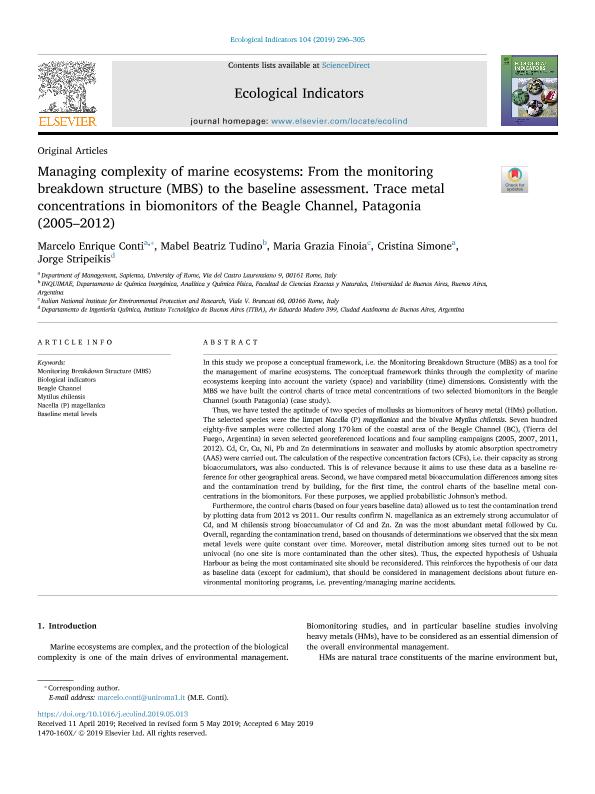Mostrar el registro sencillo del ítem
dc.contributor.author
Conti, Marcelo Enrique
dc.contributor.author
Tudino, Mabel Beatriz

dc.contributor.author
Grazia Finoia, María
dc.contributor.author
Simone, Cristina
dc.contributor.author
Stripeikis, Jorge
dc.date.available
2021-01-07T12:23:57Z
dc.date.issued
2019-09
dc.identifier.citation
Conti, Marcelo Enrique; Tudino, Mabel Beatriz; Grazia Finoia, María; Simone, Cristina; Stripeikis, Jorge; Managing complexity of marine ecosystems: From the monitoring breakdown structure (MBS) to the baseline assessment. Trace metal concentrations in biomonitors of the Beagle Channel, Patagonia (2005–2012); Elsevier Science; Ecological Indicators; 104; 9-2019; 296-305
dc.identifier.issn
1470-160X
dc.identifier.uri
http://hdl.handle.net/11336/121696
dc.description.abstract
In this study we propose a conceptual framework, i.e. the Monitoring Breakdown Structure (MBS) as a tool forthe management of marine ecosystems. The conceptual framework thinks through the complexity of marineecosystems keeping into account the variety (space) and variability (time) dimensions. Consistently with theMBS we have built the control charts of trace metal concentrations of two selected biomonitors in the BeagleChannel (south Patagonia) (case study).Thus, we have tested the aptitude of two species of mollusks as biomonitors of heavy metal (HMs) pollution.The selected species were the limpet Nacella (P) magellanica and the bivalve Mytilus chilensis. Seven hundredeighty-five samples were collected along 170 km of the coastal area of the Beagle Channel (BC), (Tierra delFuego, Argentina) in seven selected georeferenced locations and four sampling campaigns (2005, 2007, 2011,2012). Cd, Cr, Cu, Ni, Pb and Zn determinations in seawater and mollusks by atomic absorption spectrometry(AAS) were carried out. The calculation of the respective concentration factors (CFs), i.e. their capacity as strongbioaccumulators, was also conducted. This is of relevance because it aims to use these data as a baseline referencefor other geographical areas. Second, we have compared metal bioaccumulation differences among sitesand the contamination trend by building, for the first time, the control charts of the baseline metal concentrationsin the biomonitors. For these purposes, we applied probabilistic Johnson's method.Furthermore, the control charts (based on four years baseline data) allowed us to test the contamination trendby plotting data from 2012 vs 2011. Our results confirm N. magellanica as an extremely strong accumulator ofCd, and M chilensis strong bioaccumulator of Cd and Zn. Zn was the most abundant metal followed by Cu.Overall, regarding the contamination trend, based on thousands of determinations we observed that the six meanmetal levels were quite constant over time. Moreover, metal distribution among sites turned out to be notunivocal (no one site is more contaminated than the other sites). Thus, the expected hypothesis of UshuaiaHarbour as being the most contaminated site should be reconsidered. This reinforces the hypothesis of our dataas baseline data (except for cadmium), that should be considered in management decisions about future environmentalmonitoring programs, i.e. preventing/managing marine accidents.
dc.format
application/pdf
dc.language.iso
eng
dc.publisher
Elsevier Science

dc.rights
info:eu-repo/semantics/openAccess
dc.rights.uri
https://creativecommons.org/licenses/by-nc-nd/2.5/ar/
dc.subject
MARINE ECOSYSTEMS
dc.subject
BASELINE ASSESSMENT
dc.subject
TRACE METALS
dc.subject
BEAGLE CHANNEL
dc.subject.classification
Química Analítica

dc.subject.classification
Ciencias Químicas

dc.subject.classification
CIENCIAS NATURALES Y EXACTAS

dc.title
Managing complexity of marine ecosystems: From the monitoring breakdown structure (MBS) to the baseline assessment. Trace metal concentrations in biomonitors of the Beagle Channel, Patagonia (2005–2012)
dc.type
info:eu-repo/semantics/article
dc.type
info:ar-repo/semantics/artículo
dc.type
info:eu-repo/semantics/publishedVersion
dc.date.updated
2020-11-20T14:50:40Z
dc.journal.volume
104
dc.journal.pagination
296-305
dc.journal.pais
Países Bajos

dc.journal.ciudad
Amsterdam
dc.description.fil
Fil: Conti, Marcelo Enrique. Università di Roma; Italia
dc.description.fil
Fil: Tudino, Mabel Beatriz. Universidad de Buenos Aires. Facultad de Ciencias Exactas y Naturales. Departamento de Química Inorgánica, Analítica y Química Física; Argentina. Consejo Nacional de Investigaciones Científicas y Técnicas. Oficina de Coordinación Administrativa Ciudad Universitaria. Instituto de Química, Física de los Materiales, Medioambiente y Energía. Universidad de Buenos Aires. Facultad de Ciencias Exactas y Naturales. Instituto de Química, Física de los Materiales, Medioambiente y Energía; Argentina
dc.description.fil
Fil: Grazia Finoia, María. Università di Roma; Italia
dc.description.fil
Fil: Simone, Cristina. Università di Roma; Italia
dc.description.fil
Fil: Stripeikis, Jorge. Instituto Tecnológico de Buenos Aires; Argentina
dc.journal.title
Ecological Indicators

dc.relation.alternativeid
info:eu-repo/semantics/altIdentifier/url/https://www.sciencedirect.com/science/article/abs/pii/S1470160X19303474
dc.relation.alternativeid
info:eu-repo/semantics/altIdentifier/doi/http://dx.doi.org/10.1016/j.ecolind.2019.05.013
Archivos asociados
